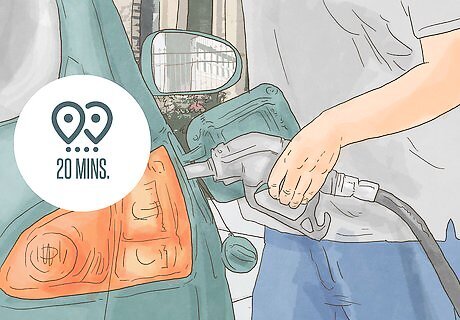
views
Weighing the Differences

Determine which subjects are important to you. When you’re weighing the difference between public and private school, curriculum is a good place to start. Almost all public schools follow the same curriculum because they’re bound by federal law, but private schools are not. Public schools tend to emphasize core subjects, like math, science, English, and social studies. This well-rounded education is good preparation for your child’s college career. Private schools are not bound by the same curriculum requirements that public schools are, so they may emphasize different subjects, or specialize in a particular type of curriculum, like the arts.

Determine what accommodations, if any, your child needs. If your child has a learning or physical disability, knowing what accommodations or help your child requires to succeed in the classroom can help you decide on a school, private or public. All schools that receive government funding are required to abide by the Americans with Disability Act, whether they are private or public. Private schools run by religious institutions are not subject to the ADA, but some states have passed laws that regulate those schools in other ways. Although private schools can have admission requirements, they cannot refuse a student based solely on a disability. Private schools also must amend any policies or procedures that deny access to students with disabilities.

Decide how important diversity of student body is to you. When deciding what matters to you about the school your child attends, you might want to consider the diversity of the student population. Do you want a school that reflects your child’s own background or one with more diversity? Most studies show that private schools are more accepting of a diverse student body and tend to mount more stringent anti-bullying campaigns. However, while private schools are more accepting of a diverse student body, public schools tend to actually have more diversity among their students.

Decide if you want co-ed or single-gender education. Whether you send your child to a single-gender or co-educational school is a personal decision, but make sure you know the pros and cons of both types of education before you choose a school. Some studies show that girls do better in single-gender educational settings, particularly in math and science courses, because they are free from the gender stereotyping that might convince them that boys are better at those subjects. However, some studies show that co-ed classrooms and schools more adequately prepare students for life after school; the world is, after all, co-ed. Additionally, there isn’t a lot of research to support the idea that single-gender schools always result in higher test scores or less gender stereotyping.

Take into account teacher quality. Because public and private schools are governed by different federals laws and regulations, the quality of teachers can vary. Knowing how important teacher quality is to you and your child can help you weigh the difference between public and private schools. Public schools are required by law to employ certified teachers. This means that every teacher your child has will have a teaching certificate. Private schools are not required to employ certified teachers. This can be great for your student if, for example, their history teacher has a PhD in history (but no teaching certificate). But, depending on the school, the teachers might not be as good as those you would find in some public schools. Because private schools are not required to accept students with special needs – although some do – they might not have a special education teacher on staff. Keep in mind that this is a very general view on public vs. private school teachers – there are fantastic and not-so-great teachers in both systems.

Ask about testing scores. Although you shouldn't put too much stock in a school's online ratings, you should still ask about individual schools' testing scores. Students at private schools tend to outscore public school students on standardized tests, which can affect your child's ability to get into college. However, there is some debate about this general assessment - researchers have used the same data to come to conflicting conclusions, and other factors - like socioeconomic status, can influence of student's scores, regardless of where they are educated.

Decide how important extra-curricular activities are to you and your child. The number of extra curricular activities, including sports, offered by public and private schools can vary greatly. Knowing how important a variety of activities and sports is to you can help when assessing the differences between schools. Public schools tend to have a greater variety of activities, clubs, and sports teams than private schools because they get a certain amount of funding for this. Public schools are also required to abide by Title IX, which requires equity in activity and sport funding, so whether you have a son or daughter, they’ll have a good chance of having a number of teams to choose from for tryouts. Private schools will sometimes offer sports and activities that public schools don’t, which is important if the sport your child plays is not very common in public schools.

Take into account class size. In general, public schools tend to have larger class sizes than private schools. If you need a school that can give more attention to individual students, you might consider a private school or a smaller public school.
Making Your Decision

Make a list. Before you start searching for schools, make a list of the things you’re looking for in a school. This list will help you keep your priorities front and center as you choose a school. Find out what district you’re in. The most basic place to start when choosing a school is knowing which district you live in. This will greatly narrow down the schools you can choose from for your child. Some school districts have what’s called “school of choice,” which means your child can choose which school in the district to attend, regardless of its geographic proximity to your home. Other districts have agreements with neighboring districts that let you choose a school outside of the district you live in. Find out if your district allows either of these options. If they don’t, your student will attend the public school associated with your neighborhood.

Decide how far you’re willing to drive. If you decide ahead of time that you’re not willing to drive more than 20 minutes to take your children to school, you can narrow down your search for a new school – public or private – right away.

Work out a budget. Before you even begin to choose between public or private, you’ll need to know how much money you can spend on your child’s education. Public schools are taxpayer-funded, so you won’t pay tuition at a public school. Private schools are privately funded, and the main way they raise that money is through charging tuition. Working out how much you have to spend on your child’s education can really help you when you make your decision.

Decide if your child needs a specialized program. Your child might need a program that specializes in teaching students with certain disabilities, or one that focuses on a particular area of their education (like an art school). Knowing what sort of program your child needs can help narrow down the list, too.

Find out how much tuition you'll pay. Tuition rates at private schools vary widely from state to state, from $3,600 to over $20,000 per year. Make sure you know what the average is in your state before you begin looking. Private School Review is a website that can be helpful in finding this information for your state. You might not necessarily have to pay full tuition for a private school if your child gets a scholarship. Some private schools offer internal scholarships, and there are a variety of national scholarships that are awarded based on everything from religious affiliation to socio-economic status. Some states also offer vouchers to defray the cost of private education. You’ll need to find out whether your state does so and how to apply for them. Again, Private School Review can direct you to that information.

Talk to other parents. Before you decide on which public school you’ll send your child to, talk to other parents and ask for their honest opinion about the school. Most parents will be honest about their and their child’s experiences. If you don't know anyone who currently attends the school, you can ask for contact information for the school's Parent Teacher Association (PTA).

Talk to the principal. Consider chatting with the principal of the school you’re interested in for your child. The principals are in charge of the school and you can get a good idea of how the school runs, and what they prioritize, by talking to the person in charge.

Ask how tuition is spent. It’s easy to assume that higher tuition rates mean a better education when it comes to private schools. Be sure you find out how the tuition money you pay is allocated. Does it get spent on the buildings or on your child’s education? A clean, inviting, cheerful learning environment is important, but you child probably doesn’t need to study somewhere that looks like a castle to get a good education.

Meet the school’s faculty. Because teacher quality can vary so much from school to school, ask to meet some of the faculty at the schools you’re considering. This can give you a much better idea of the general quality of the school’s faculty than just reading online bios or CVs can give you.

Tour the school. Schedule a tour of the private schools you’re interested in – you can learn a lot from these tours. Do the students look happy and engaged? Are the learning spaces bright and clean? You can learn a lot about a school based on your gut reaction when you visit. Taking your children along gives them the chance to see the school and decide if it feels like a comfortable environment to them.

Don’t put too much stock in online ratings. Schools in lower-income neighborhoods might have a lower rating on online rating websites, but they could also have fantastic teachers and principals. Talking to other parents will help you figure out if this is true, so don’t write a school off just because its ratings are a little low.




















Comments
0 comment